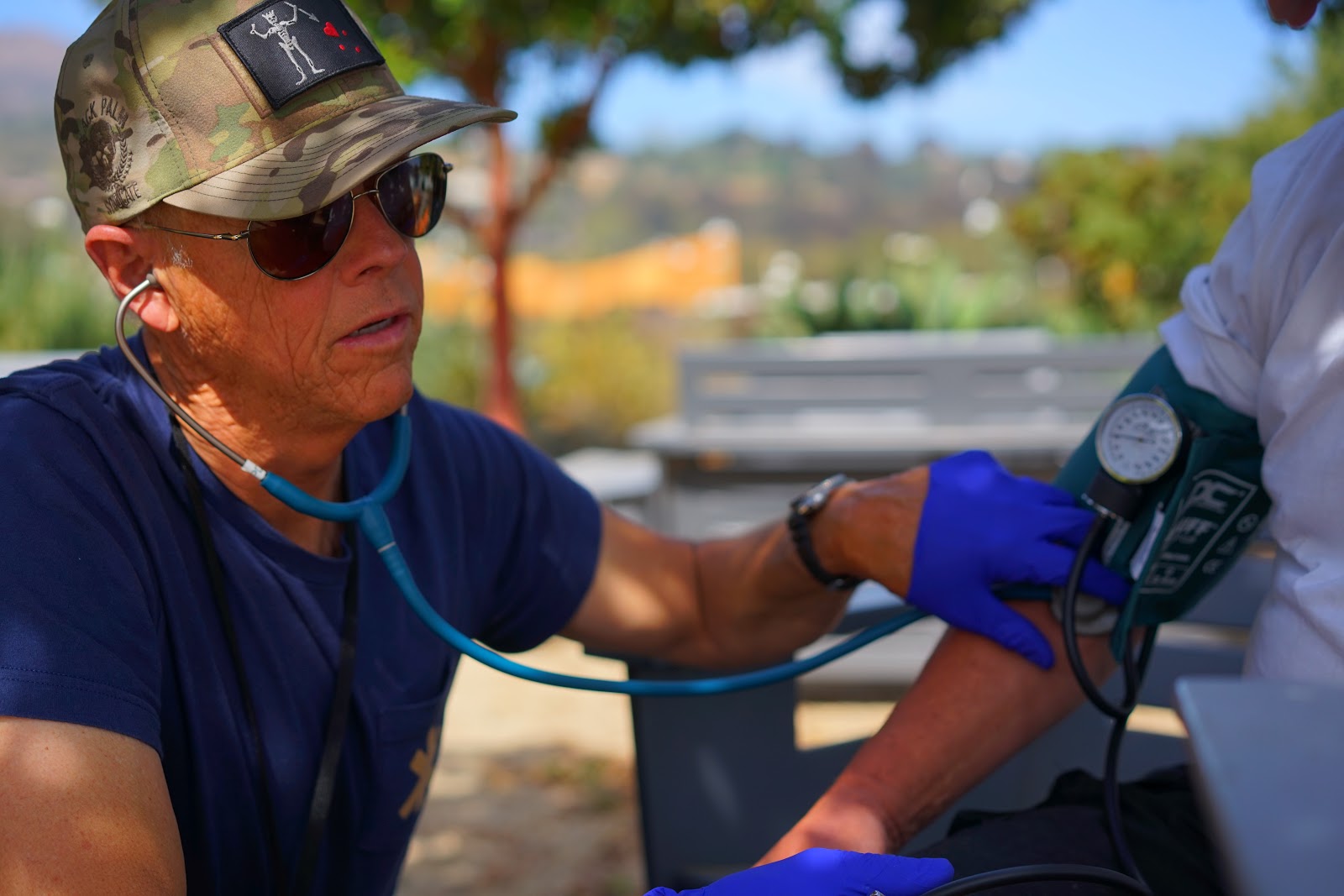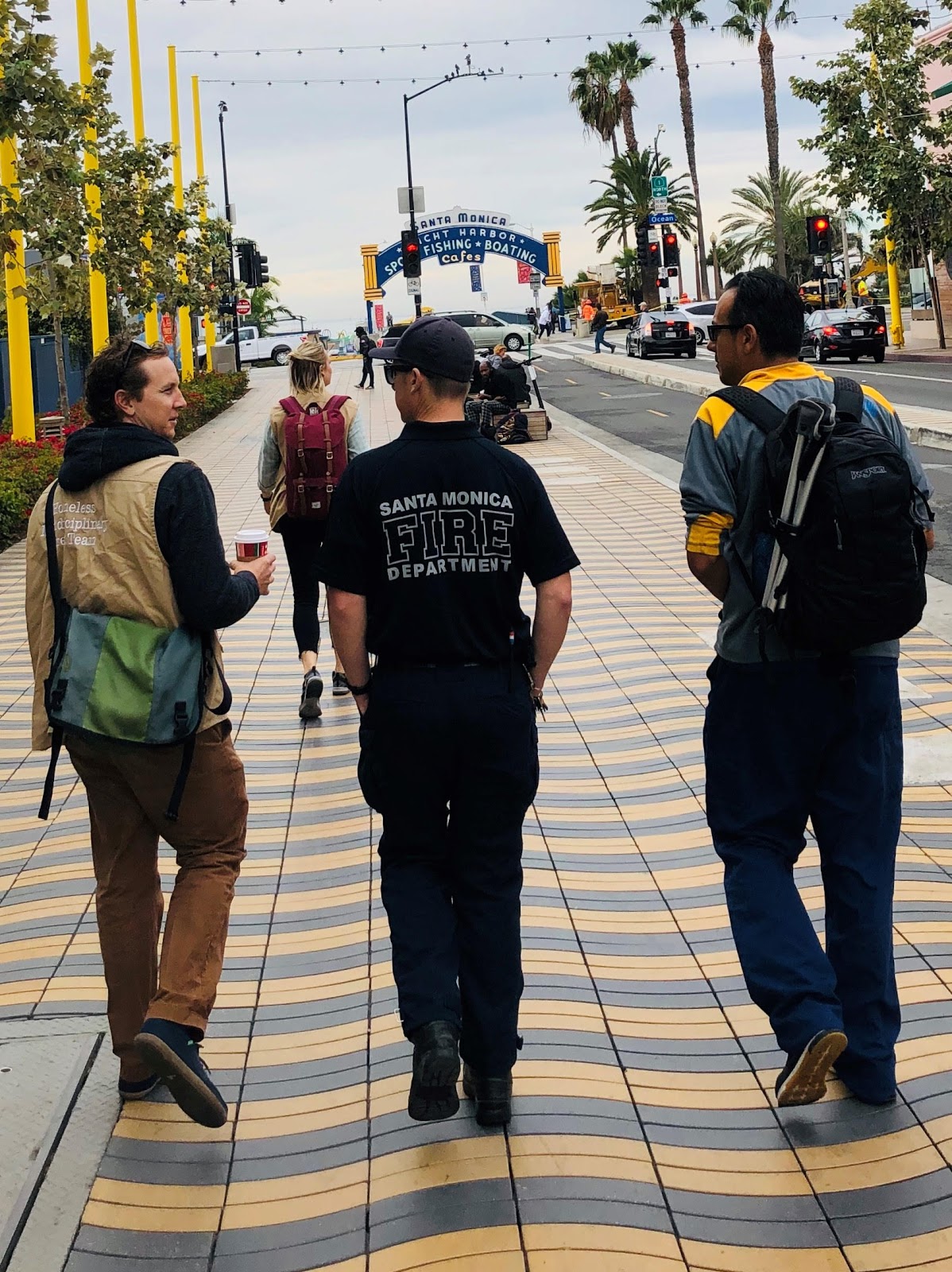The Multidisciplinary Team for Integrated Care Coordination
Figure 16. The Malibu Team features a mental health case manager, a psychiatrist, a family doctor, a skilled street medic, and a shadowing physician. Venice Family Clinic Photos.
a) Venice Family Clinic’s Street Medicine Program uses a multidisciplinary, integrated model of team-based care. The teams consist of Venice Family Clinic medical staff and social service partners, such as The People Concern and St. Joseph Center.
Key features of Venice Family Clinic’s Street Medicine Program include:
- A shared culture and demonstrated commitment to each person’s health, empowerment, well-being and housing stability.
- Understanding and respect for each staff person’s role and equity among partners.
- Employing creative solutions to meet the individualized needs of patients; for example, utilizing the most trusted source to relay sensitive information irrespective of role.
- Conducting daily or weekly huddles for case conferencing with team staff from the partnering organizations to maximize collaboration in treatment planning for complex patients.
- Frequent and secure communication among all partners via text, email and phone.
- Flexible functions within staff roles; for example, any team member can distribute sandwiches, water, gift card, transportation voucher, etc.
- Revolving team leadership based upon domain expertise and best fit for the task.
Figure 17. The team in action in Malibu. Taken by Alex Gittinger of The People Concern.
b) How Venice Family Clinic’s Street Medicine care teams work. The role of the team is to:
- Remain open to referrals from any source.
- Meet people directly where they are in a variety of settings including the streets, parks, beach, hospitals, clinics, shelters, respite care facilities, housing, and other locations.
- Obtain signed consents and client participation authorizations in order to communicate effectively with partners and other service agencies who assist in all aspects of shared-care coordination, advocacy, linkage to services, benefits acquisition and housing registry.
- Make connections with hospital staff, emergency services and law enforcement personnel to facilitate communication and service navigation.
- Provide direct linkage to affordable housing resources, such as permanent supportive housing, rapid re-housing, or family unification, with access facilitated by outreach/case management partners.
- Provide social care through outreach/case management partners, supporting the transitions to and coordination between needed community resources and services.
- Link patients to resources for safety, food, clothing, shelter, health, behavioral health and substance use services, housing and transportation.
- Integrate diverse perspectives of all team members to achieve cultural sensitivity and to maximize the opportunity for a complex population to overcome challenges.
Figure 18. Peter Miller, street medic, checks vital signs for a patient in the field. Taken by Dr. Coley King of Venice Family Clinic.
c) Team member attitudes, skills and knowledge. Every team member assumes their role to achieve the best outcome for the patient. Key characteristics of Venice Family Clinic’s Street Medicine Team members include:
- Being a reliable team player.
- Listening and building quick rapport for mutual trust.
- Valuing and respecting each person on the team.
- Showing empathy and building on the strengths of each patient.
- Building on the strengths of each staff member.
- Being flexible and open to diverse perspectives.
- Demonstrating cultural sensitivity.
- Embracing the mission, values and guiding principles of Venice Family Clinic’s Street Medicine Program
- Learning the common language and acquiring cross-sector literacy.
- Practicing one’s discipline and becoming an expert in one’s role.
- Being creative and collaborative in problem-solving.
- Embracing conflict as an opportunity for solutions.
- Promoting health equity.
- Pursuing collective imagination.
Figure 18. Peter Miller, street medic, checks vital signs for a patient in the field. Taken by Dr. Coley King of Venice Family Clinic.
d) Team Composition. Team composition varies based upon the specific needs of the target group, funding and clinician types. The highest capacity team includes the following roles:
- Prescribing medical clinician and team lead (DO, MD, NP, PA).
- Prescribing psychiatric clinician (psychiatrist, psychiatric nurse practitioner).
- Behavioral health clinician (LCSW, LMFT, PsyD).
- Substance use disorder (SUD) specialist, addictionologist.
- Outreach care coordinator and/or case managers and/or outreach workers including peer specialists or community health workers with lived experience.
- Housing navigator.
A bare-bones team may consist of:
- Prescribing medical clinician.
- Housing navigator.
- Support from a psychiatric clinician or therapist via teleconsultation.
Team Formation— Venice Family Clinic currently leads nine Street Medicine Teams geographically located on the Westside of Los Angeles County. Each team is comprised of staff members deployed from two organizations—our health center and a social care agency. Venice Family Clinic takes the lead as the primary health care clinician and is joined by behavioral health, outreach and case management staff from the social service partner agency.
Team Type and Focus—The cross-agency teams are formed according to geography, general outreach function and sub-population focus with a priority designation based upon patients’ vulnerability, such as highest utilizers of the crisis health systems.
General outreach teams are contacted by a central dispatch entity which triages requests from the wider community (of residents and businesses) seeking to refer individuals in need of assistance.
In contrast, registry-based housing teams are deployed within a certain geography using a hotspotting approach to identify individuals who meet criteria to be placed on a priority list for regional housing. Hotspotting refers to the use of hospital, emergency service, law enforcement or other forms of data to identify high-cost, high-needs patients referred to as service super-utilizers.31 General outreach teams and local community clinics and mental health agencies are also able to identify and refer individuals with tri-morbidity to registry-based housing teams.
The staffing of each team is determined by the needs and characteristics of the sub-group and funding considerations. Psychiatric and behavioral health clinicians are likely to be assigned to a registry-based team to serve a specific list of individuals with complex behavioral health conditions.



